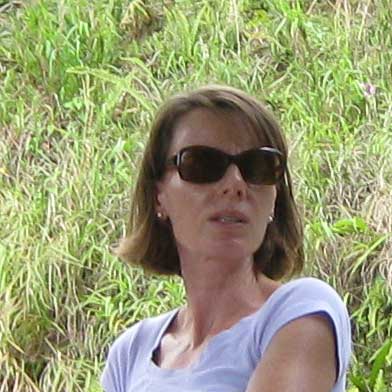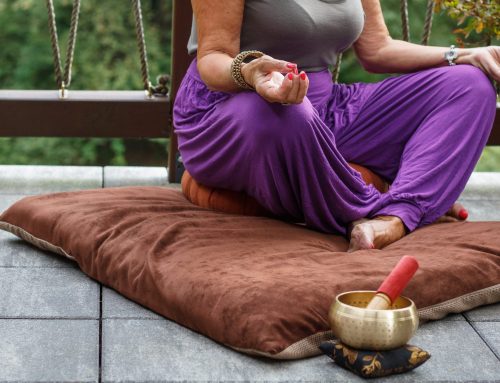By Leslie Smith
PUNAKHA, Bhutan—Sitting in Punakha Dzong —a temple and historically also an administrative centre and the former capital of this tiny mountain kingdom—we are surrounded by golden statues of Buddha the atmosphere vibrated serenity and sheer joyous power. We meditate silently sitting on the ancient floor boards, absorbing centuries of ardent positive feelings. For half an hour I silently chant the revered Buddhist mantra, Om Mane Padme Hum, which adorns Bhutanese prayer wheels and is spun endlessly into the cosmos, offering prayers and blessings for the well-being of all living beings. I feel myself surrounded by a golden light, imperceptibly floating above the floor, enveloped in warmth, and totally happy.
And it’s no wonder. Punakha Dzong is known as “the palace of great happiness or bliss” It was built by Nagawang Namgyal, the first Zhabdrung Rinpoche in 1637 and is the second largest dzong in Bhutan housing many sacred remains of religious leaders or rinpoches. It lies at the foot of the “hill that looks like an elephant” a site prophesied by the revered holy man Padmasambhava.
Traditionally, dzongs were fortified buildings which housed a monastery and an administrative centre. It was the capital of Bhutan until 1955 when the government moved from this relatively low-lying, quasi-tropical valley (at a mere 1,200 metres above sea level), to Thimpu.
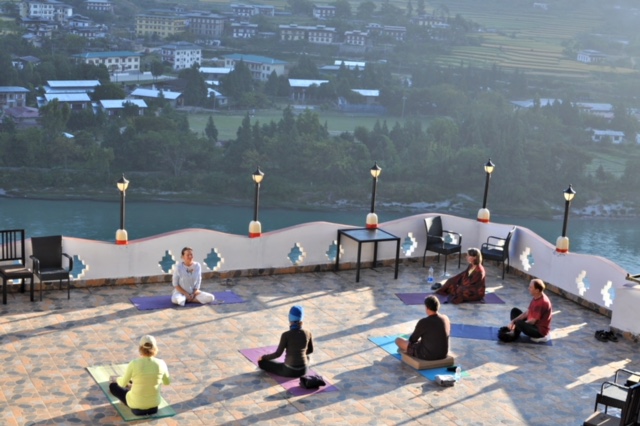
Group photo of an outdoor yoga class in Punakha, Bhutan (photo credit: Erin Bidlake)
The dzong, at the confluence of the very holy Pho Chhu and Mo Chhu Rivers (known as the father and the mother) is tentatively listed for acknowledgement as a UNESCO World Heritage Site. River rafting has become popular on the rivers though this is considered by the Bhutanese to be sacrilegious. The jacaranda trees around the site bloom with a profusion of purple flowers each spring.
Punakha is still considered the winter capital of Bhutan, known as the Land of the Thunder Dragon, and the country’s head abbot along with his entourage of monks make the pilgrimage there on foot every year.
The country’s longest suspension bridge crosses the river and is linked to Chimi Lhakhang, the fertility temple dedicated to the naughty exploits of Drukpa Kunley, known as the Divine Madman. Crossing the bridge and passing through the rice fields, children hold up hand made book markers, written in English, declaring “I Love Bhutan.” The village at the foot of the temple is resplendent with phalluses, the symbol of fertility—painted on walls, sculpted in a variety of sizes, they are on sale in many stores. Chimi Lkakhang is a pilgrimage site for couples seeking to conceive a child. While we were there, a young woman brought her baby to be blessed and our guide, himself named Chimi, was asked to do the honours of holding the baby and passing into the inner sanctum with mother and baby.
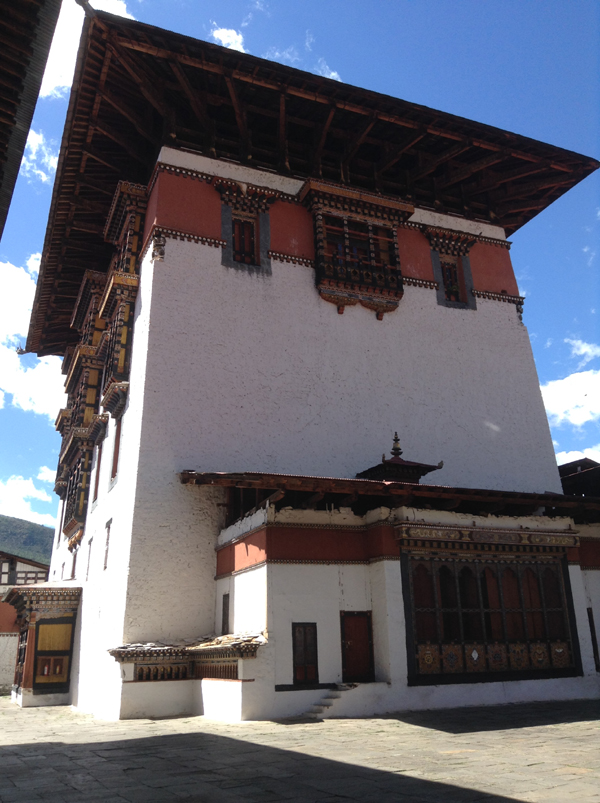
Bhutanese monasteries (photo credit: Leslie Smith)
When in Bhutan it is impossible to maintain Western notions of scientific agnosticism or even ambivalence. Bhutan’s energetic and laid-back Buddhist culture sweeps you in and gathers you into the fold. Without even noticing, you begin to consult astrologers about the most propitious date to hang your colour-coded prayer flags, each designed to bring you good health, better emotional harmony, intelligence, happiness, or a combination of blessings. Quickly, you find yourself performing the required triple prostrations in front of Buddha without a second thought. Long meditations, which you once thought to be onerous, pass blissfully. Spinning prayer wheels becomes no longer a novelty but an automatic reflex: it is empowering to be able to lifting blessings for humanity heavenward.
Indeed, the elderly congregate daily around prayer wheels, chatting animatedly to their friends and honoured with the right to wear the dark saffron robes of monks as honoured elders. They have earned their places inside the temple enclaves by dint of a lifetime of hard work and now honour their families and their society with each spin of the giant wheels which, by their revolution, recite the Sanskrit mantra, Om Mane Padme Hum: blessings to all sentient beings.
WHAT DOES OM MANE PADME HUM MEAN?
Known as the mani mantra, om mane padme hum has different interpretations but its essence remains the same. The mantra is the most widely used of all Buddhist mantras. Anyone who feels inspired may recite it. All Buddha’s teachings are contained in this mantra and so it can’t really be translated into one simple phrase.
However, Tibetan Buddhists believe that practising the mantra aloud or silently invokes the powerful and benevolent blessings of Chenrezig, who embodies compassion. Viewing the written form of the mantra has same effect as recitation so the mantra is often replicated in places where people can see it.
Spinning the written form of the mantra around in a mani (prayer) wheel gives the same benefit. Small hand wheels and large wheels, often turned by water for continuous motion, containing millions of copies of the mantra inside, are found everywhere.
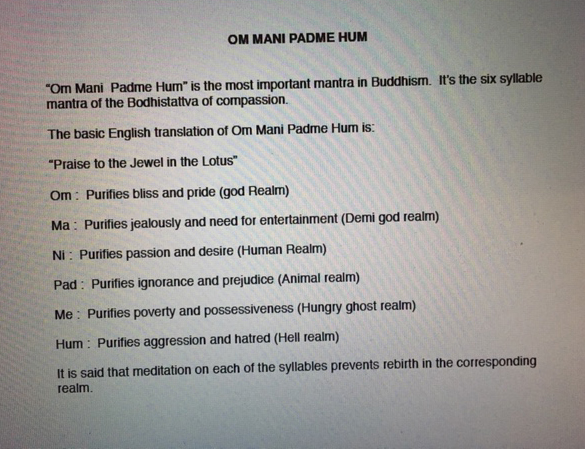
om mane padme hum mantra (photo credit: Leslie Smith)
Here’s what Dilgo Kyentse Rinpoche teaches about this powerful prayer:
”The mantra Om Mani Pädme Hum is easy to say yet quite powerful, because it contains the essence of the entire teaching. When you say the first syllable Om it is blessed to help you achieve perfection in the practice of generosity, Ma helps perfect the practice of pure ethics, and Ni helps achieve perfection in the practice of tolerance and patience. Pä, the fourth syllable, helps to achieve perfection of perseverance, Me helps achieve perfection in the practice of concentration, and the final sixth syllable Hum helps achieve perfection in the practice of wisdom.
“So in this way recitation of the mantra helps achieve perfection in the six practices from generosity to wisdom. The path of these six perfections is the path walked by all the Buddhas of the three times. What could then be more meaningful than to say the mantra and accomplish the six perfections?”
—Dilgo Kyentse Pinpoche, Heart Treasure of the Enlightened Ones


